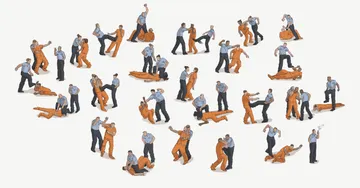I used to be the “press liaison”—later director of media relations—for the New York City Department of Correction. For nearly three years, whenever reporters thought they had a story involving the city’s jails, including about Rikers Island, I was the person they called.
Having spent the preceding decade working around criminal-justice advocacy groups, I thought I knew a few things about jails. But joining the DOC was like picking up a hockey puck for the first time: Although you knew what the thing looked like, it felt a lot harder and heavier in your hand.
In those early days, nearly all the media calls I got came from tabloid reporters—from the New York Daily News or the New York Post—usually around 3:30 or 4 in the afternoon, just late enough to make it difficult, if not impossible, to give them a good response by their deadlines. I would immediately drop whatever I was doing and let my wife know I’d be home late—again. I’d notify the commissioner, city hall and any other agencies that might need to weigh in. Then I’d begin reaching into the enormous black box that was the DOC, hoping to gather enough information to fashion some sort of reply.
More often than not, the journalist was acting on an inside tip. Back then, when no one seemed to care much about New York’s jails, senior uniformed staff routinely tried to use the media to get ahead of their rivals. They’d tell on the warden above them for allowing some spoiled chicken to be served to inmates, for example, or the chief above them who’d let a friend have a set of taxpayer-funded jet-skis. It was almost always bullshit, having little to do with the real problems of incarceration, and I regularly cursed the place I’d come to think of as the Versailles of the East River.
On the plus side, I had a shield, a suit and a black Crown Vic and could go nearly anywhere I pleased, ask questions, and reasonably expect answers. Because I was an information officer. This was a privilege I seized, not only because there was so much to learn but also because I quickly appreciated that what happens inside a jail isn’t just a budget item or an article on deadline. It was real lives—and some fraction of the responsibility for those lives was now on me.
To compensate for my initially limited knowledge, I relied on a handful of seasoned uniform staff who guided me in finding information, made introductions where necessary and helped me discern when official answers might not merit sharing with reporters.
Without these insiders, I might have accepted, for example, a security chief’s flat denial that the DOC had any such thing as a “Blood House” or “Crip House.” Being able to name specific units where many inmates had been tied to one of these groups or the other—and assuring the chief that the reporter could probably name them too—earned me a more considered response.
I worked at the pleasure of the commissioner and, indirectly, the mayor, but in my mind there was also a dotted line to the residents of New York City.
Still, sometimes, at the end of a long day, I’d drive off of Rikers Island, through Queens, over the 59th Street Bridge into Manhattan, and feel like I was entering an alternate universe. Amid the sparkling Midtown skyscrapers and plump Upper East Side townhouses, it was easy to believe that no one cared about the work I did or the place I’d left just 40 minutes earlier. And why would they? Sending someone to jail is the happy ending in most crime stories. Anyone not touched by the system was unlikely to understand what I was learning: Going to jail actually marks a story’s beginning.
Once in a while, the public got a glimpse of this. Although the national paper of record neglected the local jails then, one of its reporters had earnestly investigated how inmates were transported to the city’s courts. Another reporter, from a free weekly, regularly filed exposés about staff use of force and violence among inmates.
His requests for comment always spiked pulses at headquarters. But the resulting articles, even when laced with shocking photographs, never gained much traction. Apparently, viewing jail as a happy ending meant ignoring evidence that it might be worse than anyone deserved.
One of the first cracks in this willed ignorance appeared in early 2014, when a 56-year-old mentally-ill veteran charged with sleeping in a public-housing stairwell died in a severely overheated cell. The now well-known story of Jerome Murdough’s death was “broken” by a young wire-service reporter doing some good old-school journalism: He’d been studying the system and cultivating sources. His quote, attributed to an anonymous official, that Murdough had “baked to death,” made all the difference.
This defied the accepted narrative—no one deserved to die like that—and forced people across the city, and the nation, to notice. At about this time, perhaps in reaction, the New York Times assigned two fine reporters to the jail beat, adding reputation, resources, and reach to the emerging story.
Since then, much has been written about the need to reform jails in New York City and beyond. This is heartening: Morality aside, what I saw convinced me that depriving human beings of their liberty is both unnatural and impractical; it should not be done lightly or expediently. That said, in their zeal to press for better conditions for inmates, the media’s portrayal of jail staff has not been entirely fair.
When I worked at the DOC, the lower ranks of the uniformed staff shared much in common with the people on the other side of the bars. They were born and raised in many of the same neighborhoods, attended many of the same schools and, most importantly, came of age in a post-industrial economy where good-paying jobs were hard to find. One thing set them apart, though: Every last officer had knowingly signed up for and trained to do a tough job in a paramilitary organization in which questioning your boss wasn’t really an option. And whenever I asked someone why he or she had done it, I always got the same answer: “To support my family.”
Yes, many were nostalgic for a time when they could threaten inmates with violence in order to ensure order and their own personal safety. But mostly this was because they felt they were not being offered a viable alternative. Many also resented what they perceived to be an overly sympathetic view of inmates, while they were reflexively criticized for doing what society had asked of them.
Blaming those who walk a jail’s corridors for a “culture of brutality” is too easy. Responsibility also lies with the leaders of these institutions, the politicians who fund and oversee them, and, ultimately, the citizens of the city, who set the expectations. But that is unlikely to change until the storybook version of jail is replaced by an accurate understanding of what it really entails—not only for people in custody, but also for people who work there.
Robin Campbell worked with the New York City Department of Correction from 2012 through 2015. He now lives outside Baltimore and is developing a television series based on his experiences at the DOC.

